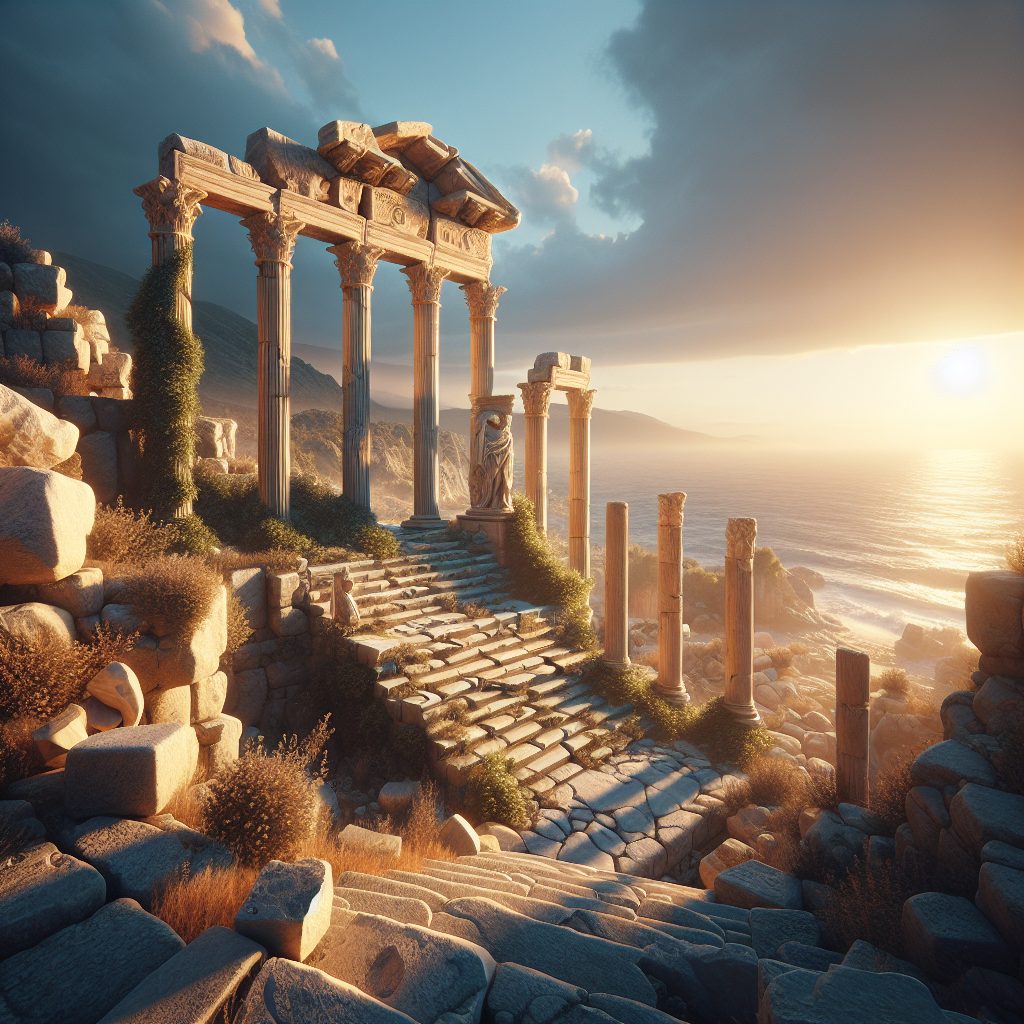Tharros ruins, an ancient archaeological site located in Sardinia, Italy, holds a significant place in history. Dating back to the 8th century BC, Tharros was originally founded by the Phoenicians as a vibrant trading post. This coastal city flourished for centuries, serving as a crucial hub for maritime commerce between various Mediterranean civilizations such as the Carthaginians, Romans, and Byzantines. What sets Tharros apart is its rich historical significance and the remarkable preservation of its ruins, offering a unique glimpse into the past.
One of the key takeaways from exploring the Tharros ruins is the proof of its strategic location and profound impact on ancient trade routes. Situated on the western coast of Sardinia, Tharros acted as a gateway for the exchange of goods, ideas, and cultures. The remnants of ancient structures, including a massive stone wall, temples, thermal baths, and a theater, speak volumes about the city’s grandeur and the vast economic and cultural influence it once held. Furthermore, the existence of both Phoenician and Roman ruins in Tharros showcases the city’s ability to adapt and thrive amidst changing political landscapes.
Moving forward in this article, we will delve deeper into the fascinating history of Tharros and explore its lesser-known aspects. Join us as we uncover the rise and fall of this ancient city, its architectural marvels, and the stories hidden within the stones. From the remnants of its ancient harbor to the enigmatic inscriptions on its walls, each chapter of Tharros’ history will captivate your imagination and transport you to a world long lost but imprinted in the fascinating ruins we can still witness today.
Key Takeaways
1. The Tharros ruins are located on the west coast of Sardinia, Italy, and provide valuable insights into the ancient Phoenician and Roman civilizations that thrived in the region.
2. Founded by the Phoenicians in the 8th century BC, Tharros served as an important trading port and naval base. The archaeological remains reveal the urban layout of the city, including houses, temples, and a defensive wall, showcasing the Phoenician architectural style.
3. The Roman period saw the expansion and transformation of Tharros, with the construction of ambitious public buildings such as a theater, thermal baths, and an amphitheater. The ruins also offer evidence of the city’s gradual decline, likely due to geographical challenges and pirate raids.
4. Excavations in Tharros have unearthed various artifacts, including pottery, jewelry, and coins, illuminating the intricate trading networks and cultural connections established by the Phoenicians and Romans. These findings highlight the importance of Tharros as a crossroads of Mediterranean civilizations.
5. The ruins of Tharros provide a unique opportunity for visitors to immerse themselves in the rich history of the area. Its location amidst stunning natural landscapes, combined with archaeological exploration, offers a captivating glimpse into the ancient past and the vibrant civilizations that once flourished there.
What is the History of Tharros Ruins?
Tharros: A Glance into the Past
Located on the western coast of Sardinia, Italy, Tharros is an ancient city that offers an intriguing glimpse into the past. This section will delve into the history of Tharros ruins, highlighting its origin, development, and eventual decline.
The Founding of Tharros
Tharros is believed to have been founded by the Phoenicians around the 8th century BCE. The natural harbor and strategic position made it an ideal trade hub, attracting various civilizations throughout centuries. This section will explore the influences and impact of these civilizations on the city’s development.
Roman Rule and Flourishing Period
In the 3rd century BCE, Tharros came under Roman rule, marking a significant turning point in its history. The Romans enhanced the city’s infrastructure, constructing paved roads, public buildings, and remarkable architectural structures. This section will elaborate on the prosperous era of Tharros under the Roman Empire.
Tharros Under Byzantine and Vandal Rule
Following the decline of the Roman Empire, Tharros fell under the control of the Byzantine Empire in the 6th century CE. The Byzantines maintained the city’s importance as a strategic port, but it faced several challenges during this period. This section will shed light on the Byzantine and Vandal rule and their impact on Tharros.
The Abandonment and Rediscovery of Tharros
In the 11th century CE, Tharros was abandoned due to recurring pirate attacks and the shift of power in the region. The city remained lost for centuries, hidden beneath layers of sand and time. This section will discuss the rediscovery of Tharros in the late 19th century and the subsequent archaeological excavations.
Ancient Treasures Unveiled
Excavations in Tharros have unearthed a treasure trove of artifacts, providing valuable insight into the lives and cultures of the ancient civilizations that inhabited the city. This section will explore the significant discoveries made in Tharros, including statues, pottery, mosaics, and architectural remnants.
The Significance of Tharros Ruins Today
Tharros continues to captivate archaeologists, historians, and tourists alike. This section will discuss the significance of Tharros ruins in understanding ancient trade routes, cultural exchanges, and the integration of different societies. It will also highlight Tharros as a cultural heritage site and its contributions to our knowledge of the ancient world.
Looking to Explore Tharros Ruins? Here’s What You Need to Know:
1. Plan your visit outside the peak tourist season to avoid crowds and fully immerse yourself in the historical ambiance of Tharros.
2. Wear comfortable footwear, as exploring the ruins involves walking on uneven terrain.
3. Engage the services of a knowledgeable guide to enhance your understanding of Tharros’ historical significance.
4. Don’t forget your camera! Tharros offers breathtaking views of the sea and the ruins, providing ample opportunities for capturing memorable moments.
5. Respect the site and its fragile artifacts by refraining from touching or removing any objects. Help preserve Tharros for future generations.
6. Before your visit, familiarize yourself with the local regulations and restrictions, especially regarding photography and access to certain areas.
7. Consider dedicating sufficient time to fully explore Tharros, allowing yourself to absorb the unique atmosphere and appreciate the intricate details of this ancient city.
8. Support the preservation efforts by visiting the onsite museum and contributing to conservation initiatives.
9. Take a moment to relax and soak in the beauty and tranquility of the Tharros shoreline, offering a serene backdrop to the remarkable ruins.
10. Share your Tharros experience with others, spreading awareness of this historical gem and encouraging others to explore its ancient wonders.
Frequently Asked Questions
1. What is the significance of Tharros ruins?
The Tharros ruins hold immense historical significance as they are the remains of an ancient Phoenician city located on the western coast of Sardinia. These ruins provide valuable insights into the civilization, culture, and architecture of the Phoenician and Roman eras.
2. When were the Tharros ruins built?
The Tharros ruins date back to the 8th century BC when the Phoenicians established a trading post in the area. Over the centuries, the city developed and flourished, reaching its peak during the Roman era. It gradually declined and was finally abandoned in the 10th century AD.
3. How can I reach Tharros ruins?
To visit the Tharros ruins, one can choose to fly into Alghero or Cagliari airports in Sardinia. From there, various transportation options such as taxis, rental cars, or guided tours are available to reach the ancient site, which is situated near the town of Oristano.
4. Are there any guided tours available at Tharros ruins?
Yes, guided tours are offered at Tharros ruins by professional archaeologists and historians. These tours provide in-depth knowledge about the history, architecture, and cultural significance of the site, offering visitors a richer experience.
5. Is visiting Tharros ruins suitable for children?
Yes, visiting Tharros ruins can be an educational and enriching experience for children. They can learn about ancient civilizations, explore the ruins, and witness the artifacts on display. However, supervision and guidance are recommended, as some parts of the site may require caution.
6. Are there any nearby accommodations or restaurants near Tharros ruins?
Yes, there are several accommodations and restaurants available near Tharros ruins. Visitors can find hotels, bed and breakfasts, and holiday rentals in the nearby towns of Oristano and Cabras, which offer a range of dining options to cater to different tastes.
7. How long does it take to explore Tharros ruins?
The duration to explore Tharros ruins depends on the level of interest and exploration. On average, it can take around 2-3 hours to visit the main highlights of the ruins. However, for those who wish to delve deeper into the site’s history, spending half a day or more is ideal.
8. Can I take photographs at Tharros ruins?
Absolutely! Visitors are allowed to take photographs at Tharros ruins for personal use, as capturing the beauty and historical significance of the site is a common practice. However, commercial photography or filming requires prior permission from the relevant authorities.
9. Are the Tharros ruins accessible for people with disabilities?
The Tharros ruins are partially accessible for people with disabilities. While some areas and pathways may pose challenges due to uneven terrain and steps, certain parts of the site, such as the museum, are wheelchair-accessible. It is advisable to check with the site management for further information and assistance.
10. Are there any visitor facilities available at Tharros ruins?
Yes, Tharros ruins provide basic visitor facilities such as parking areas, restrooms, and a small museum that displays recovered artifacts. However, it is recommended to carry water, sun protection, and comfortable footwear as the site does not offer extensive amenities.
Final Thoughts
The Tharros ruins stand as a captivating testament to the rich history and cultural exchange experienced by the ancient civilizations that inhabited the region. Exploring the remnants of this once-thriving city offers a unique opportunity to step back in time and contemplate the lives and achievements of those who lived centuries ago. The ruins tell a story of resilience, trade, and the evolution of societies, leaving visitors in awe of the past and inspired to preserve and learn from such remarkable heritage.
As you walk among the ancient walls, visualize the bustling streets, the ships docking at the harbor, and the vibrant markets that once filled the air with activity. The Tharros ruins are not mere remnants of the past but windows into a whole different world that shaped the present. Through the preservation and appreciation of historical sites like Tharros, we can embrace our collective heritage and gain valuable insights into our shared human story.






